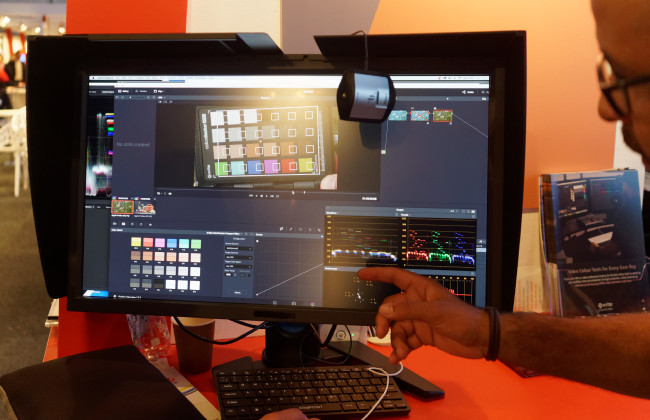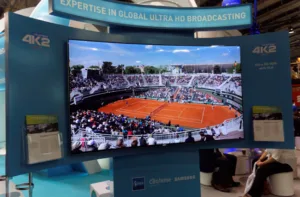ABox42 is a German STB maker that started by being more flexible than the global brands in making relatively small designs and production runs, which suits the many small cable vendors in Germany and elsewhere in Europe. At IBC, it was showing its latest M50-series box which supports UltraHD and is Broadcom-based. It is positioning its boxes as ‘smart home gateways’ as the MSOs see opportunities for revenues in this area. ABox can supply kits of sensors as well as cameras on a ‘white box’ basis as well as providing back end services and support.
 ABox42 IOT Sensors – Image:Meko
ABox42 IOT Sensors – Image:Meko
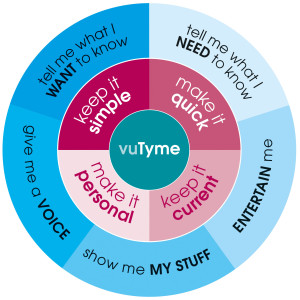 ADB is gradually transforming its business to develop more in IPTV and extend its geographical business into Latin America. At IBC, the main news was of updates to the Graphyne 2 platform and middleware. The latest version is more platform independent so that it is simpler to provide consistent user interfaces across mobile devices, tablets, PCs, smart TVs and STBs. ADB is open to a range of implementations up to a full hardware and software package.
ADB is gradually transforming its business to develop more in IPTV and extend its geographical business into Latin America. At IBC, the main news was of updates to the Graphyne 2 platform and middleware. The latest version is more platform independent so that it is simpler to provide consistent user interfaces across mobile devices, tablets, PCs, smart TVs and STBs. ADB is open to a range of implementations up to a full hardware and software package.
The company is also developing its hotel and cloud-based hospitality business, which uses its own vuTyme services and platfom. There is no requirement for a hotel-based head end, everything is in the cloud but still allowing live TV, VOD, PPC, concierge, signage and advertisements. Features include trick play of live TV. The service was developed after an extensive market research programme of hoteliers and guests. ADB is also working on implementing ChromeCast connections to hotel TVs as clients want the content from their devices on the big display and are looking for a ‘home from home’ experience. Increasingly, hotels are looking to add IT to their rooms for management and control, exploiting the IoT and ADB believes its approach will resonate with those that want to adopt this ‘room platform’ approach.
ADB still makes set top boxes but can port its software onto STBs based on MStar, Ali or Broadcom chips and can support it also on STBs from LG/Samsung/Skyworth/ZTE et al. It has 15 ODM platforms and has accelerated its porting time with the latest software. The latest “Set-back box” is the ADB-4769CD “Shadow” that supports Dual band Wi-fi, Docsis and IPTV. The boxes are designed to be mounted on the back of TVs so that they are not visible, a big advantage in hotel situations.
AMD was showing how its GPUs can be used to accelerate the processing and editing of UltraHD and HDR content and the company told us that its cards fully support Dolby Vision. The next demo that we looked was a demonstration that exploits the architecture that AMD has developed to put up to a terabyte of SSD memory directly on the graphics board. This can be used to store data for 3D rendering, but can also be used to store video to allow much faster editing and processing. The company showed a side by side against its arch rival.
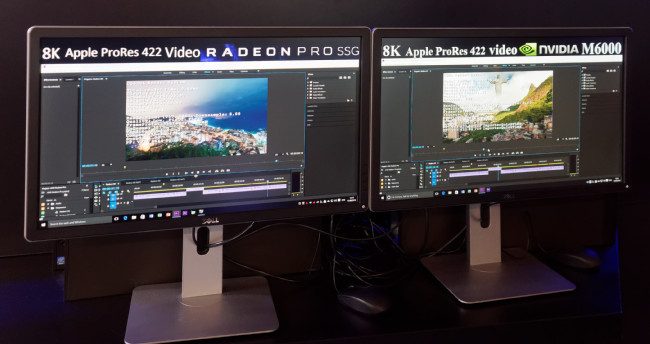
Aoto was at the show and highlighting its ability to match the level of quality desired by broadcasters but didn’t have any specific news since our Infocomm report. The main display shown was based on the M Series of panels, and with 1.5mm pitch. There was also a display of 1.2mm pitch, as there was in Las Vegas. AV Stumpfl of Austria said that Aoto was using the firm’s Wings Engine Raw 8K uncompressed super media servers to drive its demonstrations.
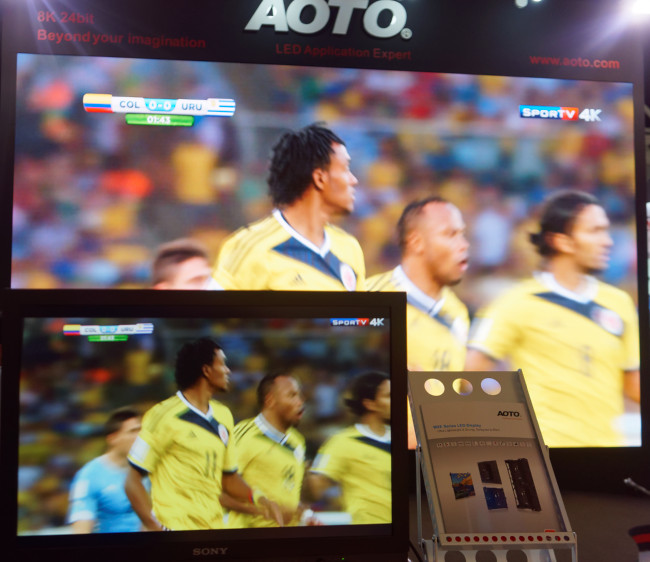 Aoto’s LEDs looked good at IBC
Aoto’s LEDs looked good at IBC
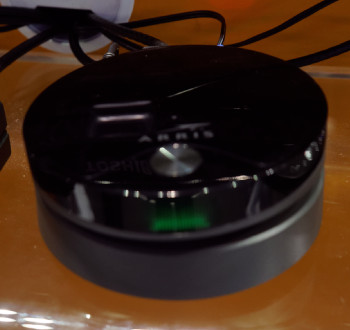 Arris started by showing us its ME7000 encoder which was creating UltraHD HEVC with HLG at 12 Mbps. We had a look at some of the designs that Arris is making available to its MSO clients and there were a number of small devices, including a ‘docking’ PVR (image right). The company has done well with media gateways for cable and satellite and these are now supporting UltraHD. The firm also has a small ip-based unit that can be used as a companion device.
Arris started by showing us its ME7000 encoder which was creating UltraHD HEVC with HLG at 12 Mbps. We had a look at some of the designs that Arris is making available to its MSO clients and there were a number of small devices, including a ‘docking’ PVR (image right). The company has done well with media gateways for cable and satellite and these are now supporting UltraHD. The firm also has a small ip-based unit that can be used as a companion device.
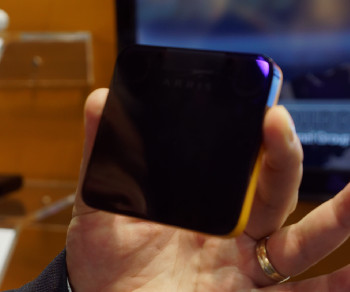
Arris is supporting MediaRoom as a platform for its clients and is working with ActiveVideo on cloud-based delivery. Finally, we looked at a top end Docsis 3.1 box that can support 4Gbps and can distribute it using 8×8 Wi-Fi. There is also support for Zigbee and a full IoT stack. Arris drew our attention to the work it has done to help MSOs with the remote diagnostics of the configuration of the user’s home network, to aid with service and support.
Barco’s Silex group told us that it now has a development board of its VC-2 standard-based light compression technology available. It currently supports HDMI1.4 at 2160P30, but work is being done to extend this to 2160P60 ver HDMI 2.0 to meet requests from the medical market and to allow 10Gbps transmission of medical data. On the broadcast side, there is another kit to allow 12G SDI to be transmitted over 10Gbps Ethernet. During the Euros this summer, the technology was used to remotely produce programmes in Paris, using feeds from Bordeaux.
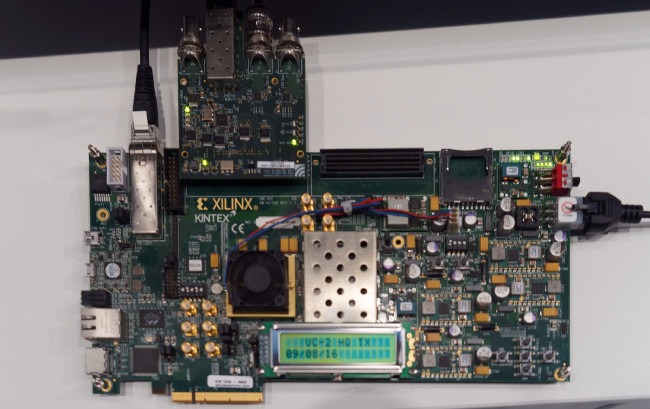 The Barco Silex ref design. Image:Meko
The Barco Silex ref design. Image:Meko
Broadcom had a meeting room, but didn’t send anybody that was qualified to talk to the press.
Calman was with management from its new owner, Portrait Displays. The company was showing its new tools for HDR and how they can be used in digital workflows whether based on HDR10/PQ or HLG. Now that HDR starts to roll out, objective metrics are needed and Calman has been a key player in this field for years. As we discovered when we talked with AV Top about its test software, there are a lot of new patterns and processes for measurement and characterisation. The software also has to be able to deal properly with metadata and staff told us that the company is close to Dolby which has been helpful for understanding PQ and the firm is also working with the BBC on HLG testing and calibration.
Portrait Displays showed us the work it is doing with HP to improve the colour calibration of notebook displays and the technology to ensure images are properly mapped to different gamuts and with a new wizard to re-calibrate, which HP is calling the HP DreamColor Assistant and allows switching between a native mode, a photo mode, sRGB, BT.709 or DCI P3. The first product, which is shipping now, is the HP Z Book mobile workstation which is available in two sizes. The company is also working with Lenovo on the X1 Yoga which has a very wide gamut. Watch out for more developments from PDL in monitors.
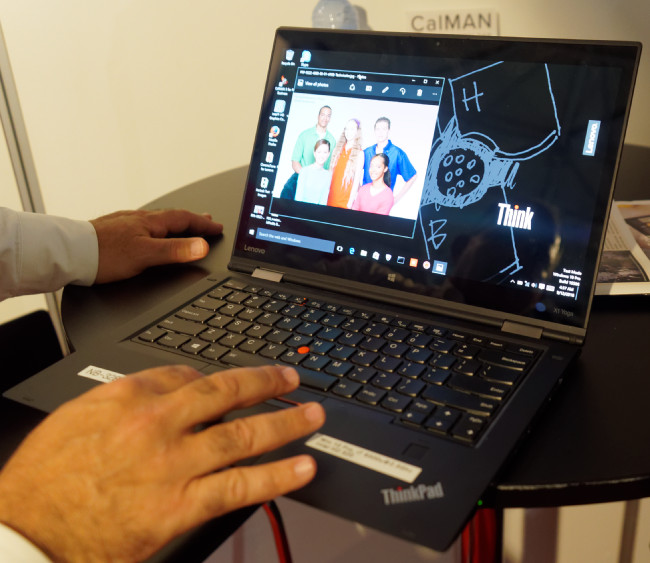
Christie had a small meeting room. It’s projectors were being used in the Big Screen Experience, and they were very impressive, but it was not promoting new products in its room. There was a demonstration of its 98″ and 84″ UltraHD touch sets.
CreateLED was showing its 2.2mm LED display and highlighting its magnetic design, but had no news compared to Infocomm.
As well as attending Ericsson‘s press event (Ericsson Highlights End to End Service), we met up with the company on its booth. There were no big developments in HDR, the topic we covered last year, although it was confirmed that the MediaRoom and MediaFirst platforms will be updated to support HDR. There were demos of the Piero 3D graphics and the company was showing some content on a Microsoft Hololens, but despite a couple of visits, we didn’t time our connection right to see the demo. Another announcement at the show was that contribution quality HEVC can now be supported on the AVP2000 encoder platform, which previously supported MPEG-2, H.264 and MJPEG. There is also a new receiver, the RX9004 coming which will decode UltraHD HEVC (and, of course, support HDR).
Eutelsat had a demonstration of an HLG broadcast that it had made with cooperation with Samsung, 4Ever and Ateme. The Hotbird HDR channel is on the Hotbird satellite (13° East) and can be accessed as follows.
- Frequency: 12015 MHz
- Horizontal polarization
- Symbol rate: 30000
- DVB-S2, 8PSK, FEC 5/6
- HEVC encoding at 30 Mbit/s
The resolution is 3840 x 2160 at 50 fps and with 10 bit colour.
The company has also worked on showing concerts in this format with Arte. The company also explained its cooperation with V-Nova (V-Nova Wins with Eutelsat and FastFilmz). Eutelsat has been working on SmartBeam which is a way of getting IP content delivered by satellite to the home and then being distributed around the home. As we have reported, this technology is being rolled out with Tricolor TV in Russia. Finally, the company told us that it has been doing well in aviation with supply of broadband wins via satellite from SAS and El Al.
Eutelsat showed HLG along with Ateme, 4Ever and Samsung. Image:Meko
Eyevis was showing a new rear projection cube that uses the TI TRP DLP technology to achieve higher brightness (from a smaller projection engine) and the company told us that is the first in the world to use that version in this application. The resolution is FullHD and will eventually available in 50″, 60″ and 75″ diagonals. At ISE it should be shown in a video wall configuration, with mass production becoming available at the end of Q1. Final specifications should be available at ISE. Eyevis told us that it continues to get good business for cubes from broadcasters and also said that it was disappointed that it would not be able to buy transparent OLEDs from Samsung Display in the future as it could “sell all we could buy!”.
HiSilicon is owned by Huawei and is viewed by some as the biggest chip vendor in China. The company started by showing us the Hi-3798 UltraHD SoC. Although described as new, the chip was announced a while ago and is now in mass production and there was a demonstration of its support of HLG, Dolby Vision and HDR10. The company was also showing how the chip can convert between these formats and was demonstrating the display of HLG content on an LG Signature HDR10 set. It can also convert HDR to SDR effectively and staff said they aimed to support “any content on any TV”.
HiSilicon also showed a box running the latest version of Android (N) and that was announced by China Mobile recently and designed to support IPTV and OTT content. The company also had a 360º VR demonstration that allowed the user’s viewpoint to be selected using a remote control.
Intopix was at the event to talk about its Tico light codec. The company is working with the Tico Alliance to develop and test interoperability. At the moment, there is no certification process, but the Alliance is coordinating testing and plugfests. The company told us that Icron Technologies is using proprietary ExtremeUSB technology to extend USB 2.0 and USB 3.1 Gen 1 in combination with Tico UHD 4Kp60 4:4:4 video (from DisplayPort) over a single CAT X cable up to 100 metres, or a single LC-LC fibre cable up to 200 metres. At the moment, some video over IP separates the video from the audio and data, but Tico is working on ensuring that all three are sent in a single stream, exploiting the compression.
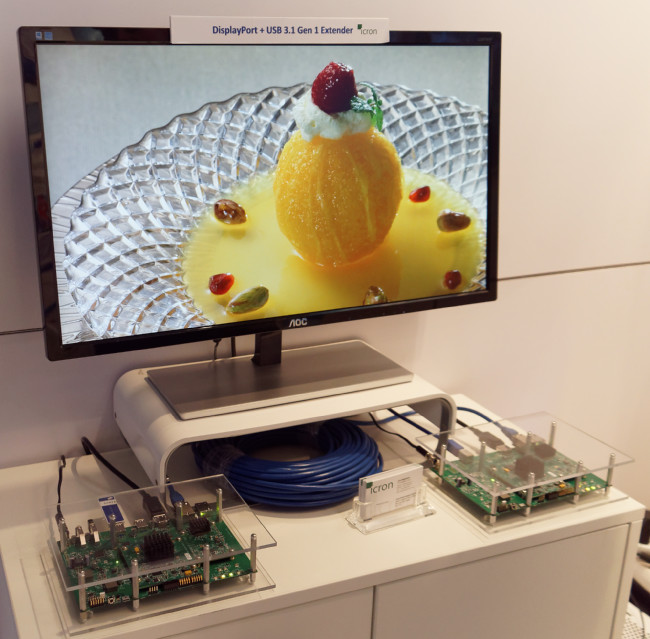 Icron’s Tico-based DisplayPort KVM. Image:Meko
Icron’s Tico-based DisplayPort KVM. Image:Meko
Intopix also told us that it has tested 8K content at 10 bit and 60fps with 4:2:2 format for use in Japan. It is also working on real time codecs that can encode and decode on an i7 6 core processor.
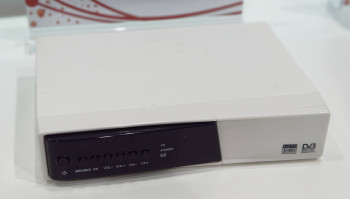 Konka was showing its DVB & OTT STB offerings, although most of its sales are in broadcast and the company told us that it has been doing especially well in Latin America. In Europe, it has a good deal with Viaccess in France for satellite boxes. A new product, based on MStar MSD7S75 silicon was the KHDS884 which was being shown in a mock-up form (picture, right) as it can be designed to meet customer requirements. It supports DVB-S2 and a 7 day EPG. Codec support includes H.265 and output is FullHD.
Konka was showing its DVB & OTT STB offerings, although most of its sales are in broadcast and the company told us that it has been doing especially well in Latin America. In Europe, it has a good deal with Viaccess in France for satellite boxes. A new product, based on MStar MSD7S75 silicon was the KHDS884 which was being shown in a mock-up form (picture, right) as it can be designed to meet customer requirements. It supports DVB-S2 and a 7 day EPG. Codec support includes H.265 and output is FullHD.
Leyard was showing its latest LED products that were seen at Infocomm, although some items were being shown in Europe for the first time. Broadcast is a good market for Leyard which supplied the NBC studio for the Rio Olympics. It told us that the latest TWA technology in 1.2mm has improved power consumption at 35% less. The company told us that 1.4mm pitch displays are shipping now with 0.9mm just about to be revealed. The 55″ Matrix clarity video wall LCDs, with 1.7mm bezels, are shipping now.
Liantronic was showing the 1.4mm LEDs that it showed at Infocomm, but told us that it can now ship 1.2mm as well. It told us that it had supplied a large display to Volkswagen in Germany with UltraHD resolution. The company uses modules that are 476 x 535 (8:9) to allow double modules to be combined to match to 16:9 formats.
Liberty Global made a lot of impact when it first showed the Horizon gateway box a couple of years ago, although it seemed to have some teething troubles in the roll out. Two million units have been rolled out across Europe. At IBC, the company confirmed that the next version will be based on the Virgin V6 box, with Tivo software, although work will also be done to update the software on existing boxes. The company also announced a global deal with Netflix to allow access to Netflix content to its subscribers in Europe, Latin America and the Caribbean. The Netflix content will be available on Liberty’s STBs. Virgin in the UK has been working with Netflix since 2013.
Marvell was talking about HDR and we had a discussion about ‘Cast’ TVs, like the one that has been introduced by Vizio and which is powered by a Marvell chip. Marvell uses Dolby’s VS10 technology in its SoCs to allow conversion between the different flavours of HDR.
MaxLinear and Realtek said that the companies have worked together to create a reference design combining the MxL541C, MaxLinear’s Full-Spectrum Capture four-channel, Unicable satellite receiver, with Realtek’s 4K/UHD system-on-chip (SoC) and RTL8812 2×2 802.11ac wireless transceiver. The solution provides four satellite tuners to watch, record and stream multiple channels simultaneously. The reference platform supports HEVC/H.265, ultra-high definition (UHD), UltraHD video display, H.264 1080p encoding, and high dynamic range (HDR) technologies. Linux or Android-based middleware can be used and the design enables fast channel change of half a second or less. Maxlinear also announced a new reference design with MStar‘s K7 chip.
After last year’s nightmare on the MStar booth, it was a joy this time to be welcomed onto the booth and shown around, without hassle. We started by looking at an advanced hybrid client reference design that is based on the MSA5S859. It was being shown with a DVB-S2 tuner, but others are available and HDR10/HLG and Technicolor HDR was being shown. The box can support dual CA systems and runs Linux with full support for HTML5. The K7 chip (MSA8Z17A) was being shown in an RDK IP client with support for OpenGL3.1 and four Conax CA7 streams. Again, HDR10 and HLG are supported.
An ‘Entry level’ video client was being run on an MSA6Z18 and supports the three HDR technologies and UltraHD including HDMI 2.0a and HDCP 2.2. The system runs on Linux with Open GL 2.0. The UHD output can be used to show four FullHD streams. A higher end implementation of the chip with more Flash (8GB) and 802.11ac 4×4 Wi-Fi supports HEVC/VP9 decoding in UltraHD. MStar told us that UltraHD capability is moving down the range very quickly. At the show, MStar also said that it was working with Irdeto to secure premium content on Android platforms. The company also said it would integrate with Nagra’s security on its MStar K6 and K7Plus set-top box (STB) chips and EMC5 television chip to allow access to premium UltraHD content.
 MStar’s UHD Entry Level client supports four FullHD Windows. Image:Meko
MStar’s UHD Entry Level client supports four FullHD Windows. Image:Meko
Finally, we looked at a demonstration of a UHD wireless video client with dual UltraHD decoding and HDR and supporting video over Wi-Fi. During the show, MStar said that it had integrated Wyplay’s Frog Pay TV software into its Hybrid STB chipset.
NEC is at the show as a provider of professional broadcast equipment. At this year’s show, the highlight was (as last year) on real time HEVC encoding. The company can encode HDR content with its software encoder which can process an UltraHD frame with HLG in 99ms on a workstation. Where the HDR is based on the PQ curve, only hardware encoding is offered. The company told us that it can effectively encode to around 20 Mbits for an UltraHD 60P stream.
Netrange which works on ‘white label’ smart TV solutions, said that it has done a deal with Foxconn to integrate its TVs with the Netrange middleware to allow OEMs to get access to smart functions without needing to develop them in house.
Neulion is a provider of OTT services and technologies – it has developed from Main Concept and DivX. It specialises in using its own technology and CDN to deliver OTT content globally, for the NBC and English Football League, for example. The big move announced at the show was a change to allow the company to be able to offer a payment platform on behalf of those wanting to monetise content. This facility could well be interesting to TV makers and the company has worked with Sony to enable content in North America. It has been experimenting this year with delivering UltraHD via OTT and that included “El Classico”, the soccer match between Real Madrid and Barcelona in Spain in April. The company also works with Sky to deliver the Sky Now TV service and also offers premium events on a worldwide basis.
NTT was at the show demonstrating its 8k real-time HEVC encoding which divides an 8K image into four UltraHD images. Frame rate was 59.94fps and the the compression system gets bit rates down to 85Mbps. To avoid problems at the edges of each block, extra processing covers those regions. The set up is already being used for test transmissions in Japan.
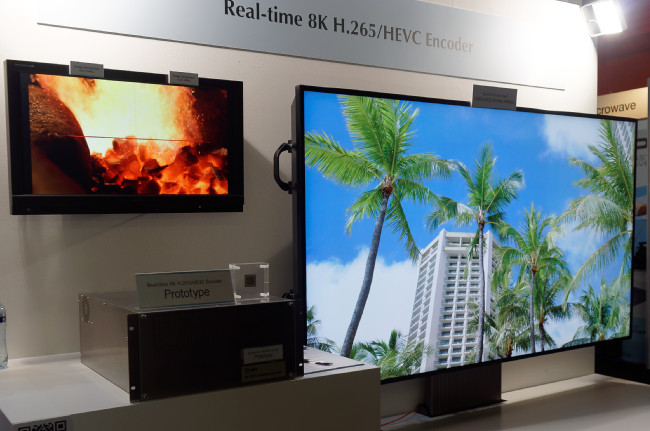
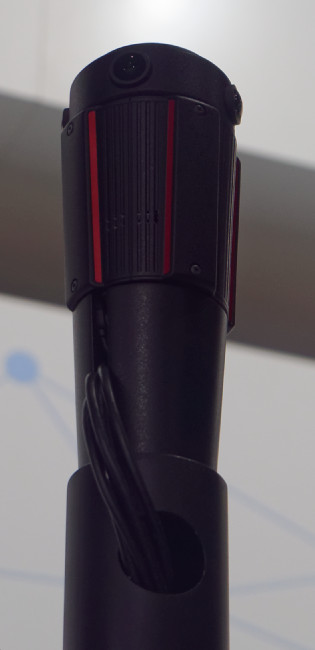 Opera TV was at the show to talk to TV, STB and SoC makers about support for its TV browser, which can be pre-integrated into SoCs to allow easy implementation of sophisticated HTML5 apps. The company told us that is already working with Swisscom and has been for a while. The Opera technology is on Swisscom’s STBs and allows access to Opera’s own TV app store which already has around 1,000 Apps. Opera Snap provides a simple way for content owners to make the content available on the Opera TV store. Opera can manage advertising on the App store and in Snap and shares this with clients.
Opera TV was at the show to talk to TV, STB and SoC makers about support for its TV browser, which can be pre-integrated into SoCs to allow easy implementation of sophisticated HTML5 apps. The company told us that is already working with Swisscom and has been for a while. The Opera technology is on Swisscom’s STBs and allows access to Opera’s own TV app store which already has around 1,000 Apps. Opera Snap provides a simple way for content owners to make the content available on the Opera TV store. Opera can manage advertising on the App store and in Snap and shares this with clients.
In Q4, Opera will add a payment system that can support Paypal and the company told us that it can run on Linux or Android-based platforms.
Panasonic had no news on displays but was showing a new high end 360º camera (shown in the image on the right), based on four UltraHD cameras and which can process the video in around 10 seconds. It will be available during 2017 for around $20,000.
QDepth is a company that is working on the automatic conversion of 2D content to 3D based on academic work being undertaken in the Netherlands. The company told us that it can offer off-line or real time conversion as a service or can license its technology. The basic concept is to work on a wide range of the different 3D cues that the human perception system works on. This is done on a frame by frame basis. For example, it exploits the feature that the atmosphere means that colours get less saturated as they are viewed from further distances. The company told us that this is effective because the “algorithm makes the same errors as your eyes” and staff told us that the ‘trick is in the pre-filtering’. A new approach is being developed to improve the algorithm even more, but after we heard about it, we were sworn to secrecy as the patent application has not yet been filed! The founders of the company were involved with the 3D specialist, Dimenco at its start.
Sagemcom announced a new range of UltraHD STBs based on Quad-core 14,000 Dmips BCM7268 and the BCM7271 SoCs from Broadcom. The company said that it already has wins for the box with ten operators.
![]() We often say that almost as interesting as who is at the show is who is not. We were surprised that SiliconCore, which has made a big point of how good its LEDs are for TV studios, was not there on its own account. However, we did spot a very good LED on the Rohde and Schwarz booth and noticed a small plaque that showed that it had been loaned by SiliconCore.
We often say that almost as interesting as who is at the show is who is not. We were surprised that SiliconCore, which has made a big point of how good its LEDs are for TV studios, was not there on its own account. However, we did spot a very good LED on the Rohde and Schwarz booth and noticed a small plaque that showed that it had been loaned by SiliconCore.
Skyworth told us that to date it has made 30 million STBs and that its success in this market is partly because it doesn’t always believe that China is the best place to make them. It has facilities around the world of its own and it also has dedicated production lines at some Flex factories. It also has invested in service and has, for example, seven service centres in India, which also support some boxes for competitors. As we heard, you have to be competitive to service products when they may cost less than $20! The company told us it made 7.7 million OTT boxes based on Android in 2015. It plans to boost this to 12 million this year and 16 million next year. As well as selling under ODM brands, the company supplies under the Thomson brand, which is controlled by Strong GmbH in the STB market. The is around 10% of the business. The company is also working in Africa and told us that it can use the Thomson brand for Skyworth TVs (which surprised us, as we understood that the licence for TVs with the Thomson brand is controlled by TCL). In terms of products, Skyworth was keen to show us its new STB being used as an entry level console. The company developed this in collaboration with Tencent. The box uses a Rockchip RK3288 Quad core Cortex A17 with a 1.8GHz Mali-T764 GPU. The miniStation G2001 runs a customised version of Android 4.4 and has support for H.265 video in UltraHD. It costs $70 in China.
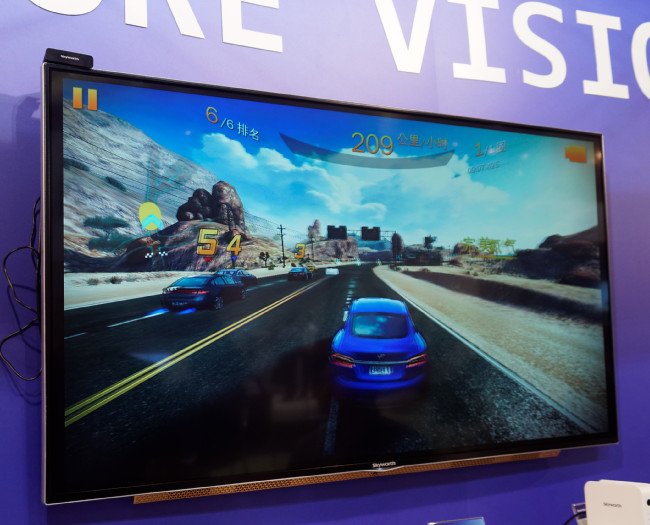 Skyworth has developed this Gaming STB with Tencent. Image:Meko We don’t seem to have reported on Transtech except “in passing”, so we thought we’d catch up at IBC. The company, which is an LED maker based in China, was founded by the founder of Retop and was established after he sold that company. That means that the management team has a lot of experience, although this was the first time that the company had exhibited at IBC. The company has a European focus in France, Spain and Germany but also sells in the US.
Skyworth has developed this Gaming STB with Tencent. Image:Meko We don’t seem to have reported on Transtech except “in passing”, so we thought we’d catch up at IBC. The company, which is an LED maker based in China, was founded by the founder of Retop and was established after he sold that company. That means that the management team has a lot of experience, although this was the first time that the company had exhibited at IBC. The company has a European focus in France, Spain and Germany but also sells in the US.
The company has indoor displays with pitches from 1.2mm to 10mm and also supports rental applications and outdoor displays from 10mm to 20mm. It also makes perimeter displays and fascias for stadiums. The company makes totems and LED posters and has supplied these to companies including ClearChannel.

Unilumin, the maker of LED displays, was at the show, but told us that it didn’t have anything really new since Infocomm.
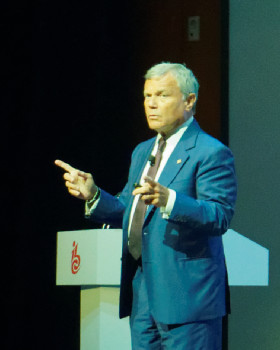 One of the joys of IBC is the quality of the keynotes. We didn’t get to as many as we would have liked to, but did attend the talk by Martin Sorrell of WPP, the world’s largest advertising agency. He’s an amusing speaker who ‘shoots from the hip’. Most of what he was talking about was outside our remit, but things we picked up on included that in twenty years, he expects the economy of China to be bigger than the US. He also talked about average ‘career lifetimes’ in big companies. These are now 6-7 years for a CEO, 4-5 years for a CFO and 3-4 years for a CMO!
One of the joys of IBC is the quality of the keynotes. We didn’t get to as many as we would have liked to, but did attend the talk by Martin Sorrell of WPP, the world’s largest advertising agency. He’s an amusing speaker who ‘shoots from the hip’. Most of what he was talking about was outside our remit, but things we picked up on included that in twenty years, he expects the economy of China to be bigger than the US. He also talked about average ‘career lifetimes’ in big companies. These are now 6-7 years for a CEO, 4-5 years for a CFO and 3-4 years for a CMO!
Sorrell also pointed out that 75% of all the growth in internet advertising is being funneled to Google and Facebook, which means his company is spending, on behalf of clients, $5.5 billion with Google and $1.55 billion on Facebook. He said that, in his view, Twitter is about PR, while the others are about branding. He continues to support AOL and Yahoo as he doesn’t want to see a duopoly develop. In his view, in recent years, retailers have dominated manufacturers, but using the new communication channels, makers can fight back, although there is a risk that Amazon and Tencent and the like will dominate.
(I also enjoyed the comment that writing is important. If you can’t write, Sorrell said, you can’t think! Man. Ed.)
X-Rite was at the show with distributor, XP Distribution which is part of the Colour Confidence group and was showing BenQ colour-controlled monitors. The company told us that having the BenQ products in its range, at pricing well below other suppliers such as NEC and Eizo, has helped to develop the market for monitors with more accurate colour for content creators and digital photographers. A new monitor is a BenQ 32″ UltraHD model that is bundled with X-Rite Elements software.
